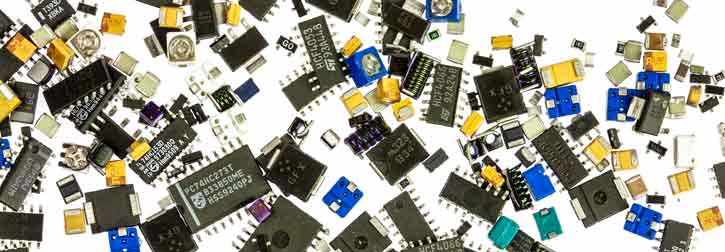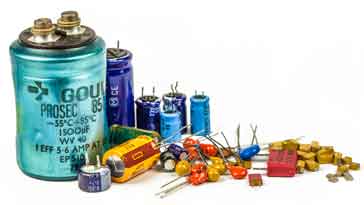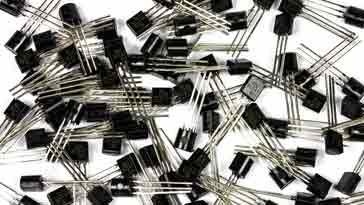How to Select the Right Electronic Components
There's more to selecting an electronic component for a circuit design than just looking at the datasheet - there are many more considerations.
Component Selection Process Includes:
Component selection considerations
It is always very important to select the right component when undertaking a new electronic circuit design.
The basic specification for a particular electronic component is not the only set of factors to take into account when selecting a particular device or electronic component.

There are other factors that will ensure that the right component is selected for the particular electronic circuit design.
Guaranteed & typical performance:
Often within a datasheet, a particular parameter may be marked as "typical."" No limits may be placed upon this. Although this is normally only given for parameters which cannot be easily guaranteed, and will normally not be too critical within a design.
Sometimes a typical performance parameter may be bounded by upper or lower limits but not always - be very wary of typical performance parameters.
Whatever the reasons for the manufacturer quoting a typical level of performance, it is necessary to assess whether this is acceptable for the given circuit design.
it is really not good practice to rely on a parameter that is quoted as "typical" when it is crucial to the design.
Make sure when reading the data-sheet that upper and lower limits are used for determining what is needed and not a typical performance.
Check the component status:
Like all other products, electronic components have a production life. They can be marked as being at a particular production status:
Preliminary: Some component data may be marked as preliminary of the component is very new and the manufacturer has not fully characterised the device. Although it can be good to use a very new component, be aware of factors that may arise from using them. Lack of characterisation - will the final datasheet be different. Will the product be available in the long term if the market does not take it it, etc.
Current: This is a device that is in full production and should be available for the foreseeable future.
NRND - Not Recommended for New Designs: This is a status that indicates that the device is coming to the end of its production life and it will be withdrawn in the near future.
Obsolescent: This means that the component has just about come to the end of its production life. It may be possible to obtain a last time buy, LTB, but after this, obtaining components will not be possible, unless they are available on the grey market, but this is not to be recommended because of issues with counterfeit components, etc.
Obsolete: This indicates that the component is no loger manufactured and will be difficult to source. It should most definitely not be used for new designs and alternatives will need to be sourced for any repairs on existing equipment.
Video: Electronic Component Life Cycle Status & Phases
Where obsolescence is a major issue, it is often possible to sign up to be put on the distribution for Product Change Notices, PCNs. These provide information about any changes in production status, and in particular they will give warning about when components are to be made obsolescent and then obsolete. This will enable action to be taken for any components of interest.
Component manufacturer
Not all manufacturers are equal, especially in terms of the way they treat their customers. Some value their customers, but others may withdraw their electronic components at short notice and with little warning
It is good to gain an understanding of the reputation of different manufacturers, and as far as possible, select the electronic components from them.
Other factors to include in assessing a manufacturer will not only be the long term availability, but short term availability, support, documentation, product quality & reliability, and ease of dealing with them in purchase and resolving issues.
There will undoubtedly be instances when it will be necessary to use a component from a manufacturer known to be unreliable, but understanding the risk, and setting up back-up plans will be part of the electronic design process.
Are second sources available
It is very important to check to see whether there is a reliable second source for any components. It is often a requirement in electronic design company processes, that a second source must be investigated for all components chosen.
It often happens that delays occur in deliveries, or a part could go obsolete from one manufacturer. Under these circumstances the availability of the component from another manufacturer could save the day.
If a second source is not available, then a near equivalent might also be acceptable for some designs. Either way, an alternative to the selected component from the selected manufacturer is best if it is at all possible.
Availability through distribution: is it on allocation?
Part availability is a critical parameter for any component. If the production of a piece of electronic equipment is going ahead, then the last thing that is wanted is missing components. Either the item will need to be manufactured with a number of shortages which can be added later, or the production could be delayed.
Neither of these scenarios is ideal, so it is always essential to check on the availability of the component and if it isn't then a second source can be checked. Occasionally it might be possible to gain an idea of whether the component may be difficult to source later in the production cycle, but this is not normally easy to achieve.

Often a component may be said to be "On Allocation." When a component goes onto what is termed allocation it occurs because the demand exceeds availability for that component. This results in long lead-times and the distributor or manufacturer may only be able to provide a portion of the ordered quantity.
Often there are peaks in demand, particularly for semiconductor devices, and lead times may extend out to 50 weeks or more in bad cases, and only a small portion of the devices ordered can be supplied.
Building a good relationship with a distributor can be very valuable in situations like these.
Beware of counterfeit components
Avoiding using counterfeit components is a big issue for many manufacturers of electronic equipment.
There are many good reasons why they should not be used and avoided at all costs. Often counterfeit components are less reliable than the original genuine product. They are also unlawful because the original design will have been stolen in some way and the IPR, etc will have been infringed.
Although costs and availability may be major advantages, their use can significantly damage the reputation and integrity of the organisation buying and using them, and also it can result in being barred from supplying equipment to government organisations.
On top of this, the lower reliability and possible performance could impact the final product. The counterfeit components are likely not to have been manufactured toth e same standards and the initial product testing is likely to have been significantly lower.
To avoid the possibility of using counterfeit components, only those with a traceable history should be used. Buying direct from the manufacturer, or through a recognised and authorised distributor will ensure that no counterfeit components have entered the supply chain.
Datasheet not available
Sometimes a data-sheet may not be available for a component. This should set a warning flag, because most reliable manufacturers will even release a preliminary datasheet when the particular component has not been fully released.
It stands to reason that if there is no data-sheet, then there is no published specification and therefore you don't know what you are incorporating into the design.

Avoid any component or sub-assembly that is in production and has no datasheet. Also be aware of anything where the datasheet remains preliminary after it is in full production. This is a reflection on the manufacturer and again performance cannot be guaranteed.
Beware of temperature performance
One pitfall that can occur is with the temerpature performance of components and sub assemblies. Semiconductors themselves change markedly with temerpature and designs need to be able to accommodate this.
Designs should accommodate the significant changes that will occur, and it is always wise to fully test over and beyond the temerpature range to ensure that the design works with all the changes that will occur.
As an example the gain of a transistor will fall significantly as the temperature goes down, and assessing whether the overall circuit will still function is a key aspect of the design.
Although datasheets will give insights into the changes that occur with temerpature, it is not possible to incorporate all the data for all temperatures.
There is a lot more to consider when selecting components than just looking at the data-sheet and reading it at face value. By being aware of the issues outside the basic performance parameters, it is much more likely that the best component for the particular design will be chosen and issues with supply and longevity are likely to be much less prevalent, although they will always happen.
 Written by Ian Poole .
Written by Ian Poole .
Experienced electronics engineer and author.
More Electronic Components:
Batteries
Capacitors
Connectors
ADC
DAC
Diodes
FET
Inductors
Memory types
Phototransistor
Quartz crystals
Relays
Resistors
RF connectors
Switches
Surface mount technology
Thyristor
Transformers
Transistor
Unijunction
Valves / Tubes
Return to Components menu . . .



